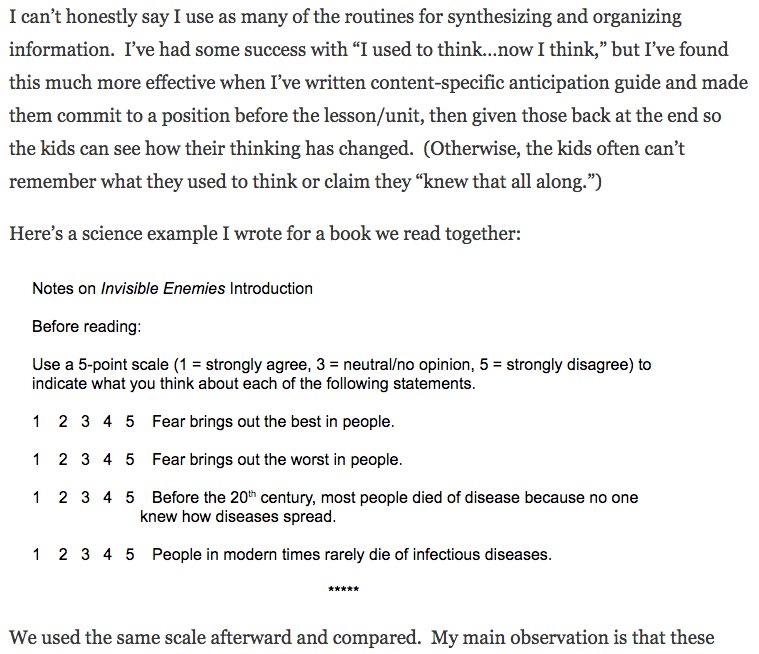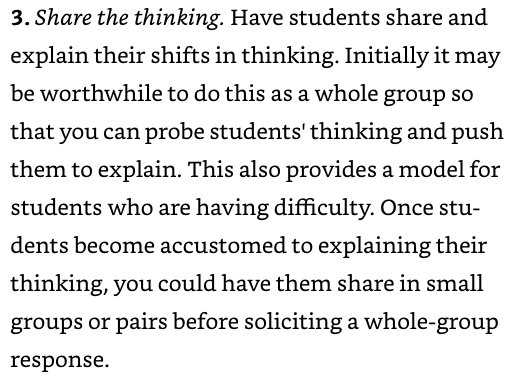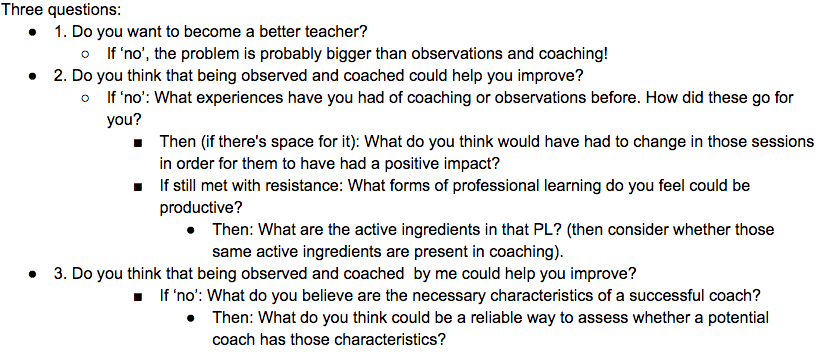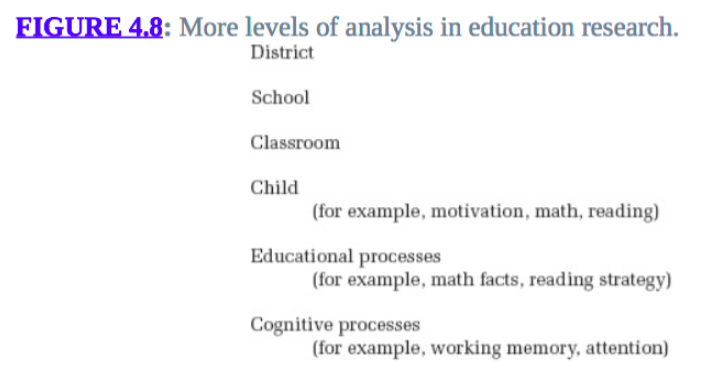Hello dear readers.
A fun week for you this week.
T1 is the first of a post series from Tom Sherrington that’s going to put Teacher Ollie’s takeaways out of business!
T2 has some good reflections from someone (I think early career teacher?) struggling with a mixed ability class.
T3 is a simply delightful podcast discussion about all things mathematics.
T4 to 8 really speak for themselves, but I’d encourage readers who are really interested in the process of learning to check out T9, which is quite a reflective piece, again from Tom Sherrington.
I’ll jump next straight to ‘thought shrapnel’. This week we’ve got some reflections on ‘should I coach this teacher’ as well as ‘Levels of analysis’. I’m really enjoying the informal opportunity to reflect, and not having to do a separate blog post! Hope you’re enjoying the shrapnel too!
I should note that I’ve stolen the phrase ‘Thought Shrapnel’ from Doug Belshaw, who does a great post each week sharing some of his thought shrapnel. You can check it out here.
Enjoy : )
(all past TOTs here), sign up to get these articles emailed to you each week here.
Tom Sherrington’s update, via @teacherhead
Here’s @teacherhead
Offering a fantastic rubdown of useful resources from the last month or so. If this was a comic, this first edition would become a collectors’ item. Only problem is, I’m nervous he’ll put ‘Teacher Ollie’s Takeaways’ out of business?. https://t.co/gmBP7p3Wkl— Oliver Lovell (@ollie_lovell) November 7, 2018
Easy mistakes to make when teaching mixed ability maths classes, via @FortyNineCubed
The is a helpful piece on some easy mistakes to make when teaching mixed ability classes. Also gives links to websites where some good resources can be found. https://t.co/g60aKikm3C who wrote this? Are they on Twitter?
— Oliver Lovell (@ollie_lovell) November 5, 2018
Hannah Fry (@FryRsquared) on the Mr Barton Maths podcast (@mrbartonmaths)
If you’re looking for an interesting discussion about maths in the world, the differing experiences of mathematicians by gender, how to solve crimes with maths, and much more, look no further than the @mrbartonmaths podcast episode with @FryRsquared! https://t.co/4fRb3mMwpY
— Oliver Lovell (@ollie_lovell) November 2, 2018
Incredible collection of free to use edu-icons, via @olicav
Looking for some good simple and clear images to use in your edu-related presentations? Look no further! https://t.co/989p1zcErj Amazing collection!!! via @olicav pic.twitter.com/tyXmTYPfEn
— Oliver Lovell (@ollie_lovell) November 4, 2018
Some snippets from Dan Willingham’s ‘When Can You Trust the Experts?’, via @DTWillingham
Here’s @DTWillingham quoting E.D. Hirsch on the limits of claiming that edu practice/policy is based upon research. A fantastic point! From the book ‘When Can You Trust the Experts’. pic.twitter.com/RXiis1mxXo
— Oliver Lovell (@ollie_lovell) November 3, 2018
More from @DTWillingham‘s ‘When Can You Trust the Experts?’. A planning template to help us avoid cognitive biases when designing a school based (or, really, any sort of) change initiative. Definitely filing this one away for future use. Love it! pic.twitter.com/rovPqfDijW
— Oliver Lovell (@ollie_lovell) November 3, 2018
Here’s @DTWillingham with 16 key questions to ask when you’re evaluating a potential educational change in your given context. From the fantastic book ‘When Can You Trust The Experts?’ I reckon you’d get a few pretty good posters out of this book @olicav ! pic.twitter.com/aVUfJqaRlZ
— Oliver Lovell (@ollie_lovell) November 3, 2018
Good resource list via @SimonBreakspear
Looking for relevant and robust research resources to inform your professional learning? https://t.co/6lexrTyo0m @learningsprint
— Dr Simon Breakspear (@SimonBreakspear) November 1, 2018
How to measure 21st century skills, a repository of assessments
A great for anyone looking into the challenge of developing (and measuring) ’21st century skills’. RAND Corp has done a massive lit review to compile all of the tests currently out there on this topic. Will be updated as more measures are developed. https://t.co/MKTSFUl64c pic.twitter.com/WrgTpH4kaG
— Oliver Lovell (@ollie_lovell) November 2, 2018
The optimum way to compile multiple-choice tests, according to psychology research
“This is the optimum way to compile a multiple-choice test, according to psychology research” https://t.co/rZN4tSUxBk
— Oliver Lovell (@ollie_lovell) November 3, 2018
Learning about the six wives of Henry VIII, via @teacherhead
A fun piece reflecting on a learning project of @teacherhead. The six wives of Henry VIII. Can see this being a good discussion piece with colleagues, or with a history class you’re hoping to improve the learning independence of. https://t.co/s05WBQ5xiV
— Oliver Lovell (@ollie_lovell) November 3, 2018
Principal/business leader partnerships. Seems like @louisevanrhyn is doing this sensitively
Pretty interesting @teacherACER podcast ep on a principal and business leader partnership program in South Africa. Main premise, asset based community approach. Quite a bit of wisdom shared. Eg, look after your teachers! 16 mins https://t.co/FyvIBnSKa6 with @louisevanrhyn.
— Oliver Lovell (@ollie_lovell) November 4, 2018
Rachel shares her thoughts on applying ‘Visible Thinking’ techniques, via @rhwave2004
First thing that I found really interesting was the type of images/stimuli that Rachel finds helpful for see-think-wonder. #ccotonline


>>>THOUGHT SHRAPNEL<<<
Should I try to coach this teacher?
This week I visited Wesern Port Secondary College to visit a couple of twitter friends, @tomacain and @MCLarenteach. Was a great visit and on the way back Tom and I were talking about the ins and outs of setting up positive cultures of observations and instructional coaching within a school context. For a while I’ve been considering barriers to coaching, and thinking about moving beyond simplistic comments that are dismissive of teachers hesitancy when it comes to being observed or coached. During the discussion with Tom, the following questions arose that we thought could help to identify which element of coaching, or a coaching scenario, is generating the hesitancy on the part of a reticent teacher. It’s important for me to aticulate that I’m in no way suggesting that these questions be directly asked to a potential coachee. It’s simply that I think that they capture well the different barriers that could be preventing a teacher from being super keen to be involved.
At this point I’m not sure how these Qs could, or should, be practically used. But I thought they were interesting none-the-less. At each stage, a ‘no’ answer indicates the need for a discussion and further exploration of motivations, past experiences, hopes, etc.
Levels of analysis
This week I re-encountered a framework for thinking that I’ve found very helpful. It’s called ‘Levels of Analysis’. Here’s an excerpt from Dan Willingham’s (@DTWillingham) ‘When Can You Trust the Experts’
Here’s an example of how the application of cognitive principles can sound good, but fail.
The spiral curriculum was introduced in the early 1960s by cognitive psychologist Jerome Bruner. The idea is that students revisit the same fundamental concepts across several years, each time with greater depth. To a cognitive psychologist, this sounds great. It means that a lot of time elapses between when kids study the same basic idea, which is very good for memory. It means that students will hear the same important ideas from different teachers, so if a student doesn’t quite understand the way one teacher explains it, there will be another opportunity the following year. So again, in terms of two processes at a cognitive level of analysis—memory and comprehension—the spiral curriculum sounds like a win.
But once it was implemented in classrooms, it became clear that a spiral curriculum was subject to at least two serious drawbacks. First, students don’t stick with any topic long enough to develop a deep conceptual understanding of it. Countries that seem to do a better job teaching math, for example, have curricula in which a small number of topics are studied intensively during the year and then are not revisited. Another drawback of the spiral curriculum was pointed out to me (indirectly) by my oldest daughter. When she revisited a topic in the fifth grade that she had studied in the fourth grade, her reaction was “Not this again!” Never mind that she had not understood it all that well the previous year. As far as she was concerned, “We did this already.” Lots of time between practice is great for memory, but it turns out to have unexpected implications for motivation.
When reflecting back on the past year, and understanding why things within my classroom, in many cases, didn’t go as well as i’d hoped, I found this passage very poignant. E.g., I’ve set up the structures for cognitive processes (Working memory), and instructional frameworks (study strategy), that are research-informed and very sound, but the issues I’ve had this year haven’t been at the ‘cognitive’ or ‘educational process level of analysis (see image below). They’ve been at the child (e.g., motivation) and classroom (e.g., culture) level of analysis.
This realisation came at a great time, because today I had my first lesson with two new classes who were getting a head-start for next year. For both of these classes I did two things that I didn’t do last year. The first is that I played a ‘getting to know you’ game at the start of the lesson, which got everyone out of their seat and meeting and greeting the other students, and playing games with them (I’ll blog about this at some point), this addresses the cultural aspect, in part. The second thing I did was address student motivations and worries. I said ‘Now, you may have noticed that my teaching is a little bit different from what you might have seen with other teachers. Many other teachers will teach you a process, then will get you to practice 10 questions on that process that are all very similar. I don’t do that. I don’t do it because when I was a student I found doing 10 similar questions in a row very boring. I also don’t do it because it’s better for your memory for us to do one or two questions on this concept today, then one again tomorrow, then one it about a weeks time, then another in about three weeks time. I just wanted to share this to put your mind at ease, because I know that a few of you might be a bit worried that we’re moving quite quickly and you haven’t had much practice on these concepts as yet. So don’t worry, we’ll have lots of practice and by the time the test come around you’ll be ready. It’s just that that practice will be spread out over time.
We’ll see how we go!




